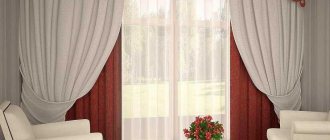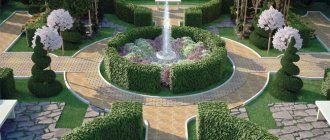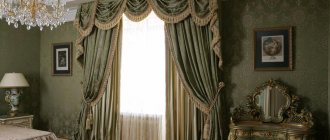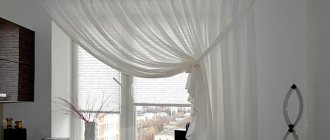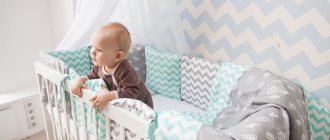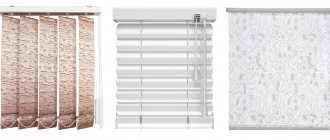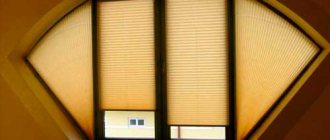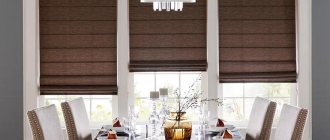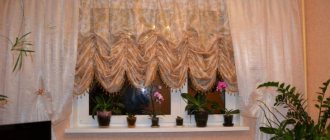Varieties of lambrequin
Before you begin the manufacturing process, you need to find out what types of products there are and what to consider when choosing material for a room. Different types of structures differ in decorative capabilities.
Soft
They are fragments of beautifully draped fabric. If you calculate the size correctly, the products look good even in a room with a standard ceiling height of up to 2.6 m.
Hard
They also serve a decorative function, but are sewn evenly, without folds. Rigid elements are often called “bando”. To keep them in shape, they are glued with dublerin from the inside.
Combined
This variety is suitable for a hall with high ceilings. In combined lambrequins, a straight and even hard part is combined with soft draperies. The products are additionally decorated with cords or other elements.
Models and types of lambrequins
There are 4 types of lambrequins:
Tough. An important part of modernity and postmodernism. Under the soft fabric there is a rigid frame made of plastic or wood, which holds a constant shape. They are installed under the ceiling and almost completely cover the ceiling. They do not blow away in the wind, but they cannot be washed.
It is impossible to remove the fabric from the frame, so you will have to wash it by hand
Soft. Fully woven pelmet. It can be based on both natural and synthetic materials. The cutting pattern is simple, so it is possible to make it even with your own hands. Unlike rigid models, it can be serviced. Can be washed in a machine at the appropriate temperature. Curtains with a soft lambrequin for the hall are suitable for classicism and baroque.
Openwork bandeau. Elegant curtains with an openwork lambrequin, created using laser cutting. The fundamental difference from others is versatility. They are appropriate in design, both modern or loft, and classicism. They can have a hard structure (an additional frame holding the fabric) or a soft one. Regular Velcro or textile fasteners are suitable for fastening.
Combined. They simultaneously collect soft and hard elements.
Options for soft curtains
There are several spectacular soft lambrequins. The choice largely depends on the style of the room.
Swags
This is a beautiful curtain design element. Swag is a semicircular piece with slightly sagging folds of drapery. It is attached to the cornice using curtain tape. Most often, swags are used in interiors decorated in a classical style.
Tie
The element is a spiral or vertical drapery. It also has a name - jabot or jabot.
This curtain accessory looks like a tie - it is a vertical component that forms spiral folds. It can be helical or lush cascading.
The narrow version with counter pleats looks good.
Coquille
The decorative element adorns clothes and curtains. Typically made from lightweight, thin fabric.
The mold is a strongly flared oval or circle, cut in a spiral. All sides of the product must be processed. The element itself can be 1- or 2-layer.
Buffs
Used for finishing clothes and lambrequins. They are volumetric assemblies that are secured to the fabric using a stitch.
Bell
This is not a full-fledged lambrequin, but a detail of it. The shape of this drapery resembles a bell. It helps to complete the curtain design.
The role and significance of lambrequins in the interior of the living room
Lambrequins - an elegant design for the upper part of the window.
The framing does not have a functional meaning. But you can hide minor imperfections in a window opening. Lambrequins will add comfort, special charm and aesthetics to the living room interior. They can decorate not only windows, but also doorways.
The main advantages include:
- They can visually hide uneven ceilings and minor flaws in the window opening;
- thanks to the lambrequins, the interior of the hall will sparkle with new colors. It will exude luxury and style;
- A wide range will allow you to choose a product for every style. Plus, there is the opportunity to sew them to order, according to your own idea;
- can visually enlarge the room.
The main disadvantage of lambrequins is their high price.
High-quality material is expensive. And if you try to sew the product yourself, although it will be somewhat cheaper, it will take a lot of time. And not everyone can do this. This requires skill.
Lambrequins - elegant design of the upper part of the window
Types of rigid lambrequins
There are different types of solid curtain parts. Not everything can be done at home.
Openwork
There are different types. Even the simplest openwork strip is the result of factory production, where a laser can be used to create patterns. In addition, openwork modular systems are presented on the market. They have a complex design. More massive openwork details are located on the sides, narrow ones are in the center.
Thanks to this arrangement, the lambrequins do not block the penetration of sunlight.
The patterns themselves can be anything - from strict and laconic to intricate.
With a straight, curly edge
Most often these are strip or plank structures. They are suitable for almost any room, incl. rooms with a standard ceiling height of 2.6 m. Moreover, plank components are often made from rolled fabric, which is produced with a pattern repeating along its length. Therefore, you can purchase such material without fear that there will be a discrepancy somewhere. This applies to an element with a figured edge - coupon roll material is purchased for it.
Kinds
According to the types of fabrics and features of the manufacturing technology of the product, there are:
- soft;
- hard;
- combined;
- openwork (curly).
The so-called soft ones are sewn from light fabrics using various decorative elements, hard ones are made from thick curtain fabrics , using non-woven fabric or other materials. In the manufacture of combined structures, elements of both types are used . Openwork - made industrially from two-layer fabrics.
To decorate the lambrequins themselves, the following types of decorative elements are used: swags, de jabot, molds, tie, bell, flips, ruffles, puffs, balloons. When designing such decorations, it is necessary to take into account that they can add additional volume to the main structure. For example, the height of the swags should not exceed 1/5 of the curtain, otherwise they will interfere with natural daylight.
To prevent curtains with a lambrequin from visually weighing down the room, you need to correctly plan their height. By choosing it correctly, you can regulate both the illumination of the room and the appearance of the window as a whole.
Lambrequin fabrics
Soft and hard products are made from different fabrics. The choice depends on the desired effect.
Veil
Translucent fabric looks elegant and gentle thanks to its fine structure and wide range of shades, incl. the ability to create spectacular gradient transitions. This is a plastic material with a matte surface, which allows you to create soft draperies and multi-layer structures.
Organza
Transparent fabric, thinner in comparison with chiffon and veil. Organza can be made from natural silk, viscose or polyester. It has a pleasant, unobtrusive shine.
Felt
It is a dense material, and is used mainly for openwork structures. Modern synthetic felt does not crumble, and it is convenient to cut patterns on it using laser technology.
Chiffon
It is a translucent fabric with a matte surface that scatters light well, but is denser than a veil.
Chiffon can be made from synthetic and natural fibers.
Atlas
This is a dense fabric made from natural or artificial fibers. Features a shiny surface. Forms heavy draperies.
Lambrequin material
In design, it is better to use curtains and lambrequins from the same material or even a collection. But, if different models are used, it is important to maintain a combination of texture and pattern. In total, several materials are used for lambrequins.
Veil
Lightweight, simple material, originally developed for making curtains. He copes with his tasks well. It does not block direct sunlight, but diffuses it, making the rays soft and pleasant.
The veil can be in different colors, which makes it universal. There are also gradients that smoothly flow from one shade to another. The fabric does not lose its saturation over time.
Another ability of the veil is natural drapery. Unlike natural materials, it does not wrinkle and is not prone to fractures. Folds in a neat cascade, without preparing fabric, starch or wax.
Organza
A tough, coarse thin fabric made from silk, polyester or viscose. In the traditional recipe, two fibers are mixed. The resulting fabric is transparent, diffuses light well, and is very light.
There are two types:
- Matte. Opaque material, slightly textured to the touch. Organza of this type is suitable for windows on the sunny side.
- Brilliant. The surface is bright, glows in the sun, glitters. Often used in children's rooms.
Processed by etching, embroidery or printing. Decoration is made using perforation or laser cutting.
Felt
Felt fabric can be based on natural wool or plastic threads. The material is dense, painted in different colors. It is attached to the cornice using a special adhesive layer.
Felt is not prone to fading in the sun. An openwork bandeau is often made from felt. The only drawback of a felt lambrequin is that it cannot be washed. Dust, pet hair, small debris - all this sticks and gets tangled in small threads and it is impossible to wash off the dirt in the machine.
It is better not to hang curtains in the kitchen with an openwork felt lambrequin, as grease splashes will settle on the surface of the fabric.
Chiffon
Lightweight, flowing fabric made from a cotton or silk base. Simple curtains are made on the basis of chiffon. Can be combined with any type of curtains. Easily replaces regular tulle.
The palette includes warm, cool and neutral shades. Chiffon textiles can be used in any interior, from classicism to modern and high-tech.
Curtains with a lambrequin for a bedroom made of chiffon will be comfortable, as they will fill the room with freshness. They are convenient in design, as they offer a lot of colors.
Atlas
Silk-based material with bright shine and expressive color. Satin fabric looks impressive in the living room or bedroom. Density allows you to protect the room from light.
Curtains with a rigid lambrequin for the hall will protect from the sun at its zenith. Satin is durable, difficult to tear or cut, so it is not afraid of pets.
The fabric can be washed in a machine on the appropriate cycle. To get rid of shine, satin can be combined with a regular veil or chiffon.
It is easy to drape, does not break, and is not prone to wrinkles or unevenness.
DIY lambrequin
To make a product, you need to find good templates and patterns. In addition, care must be taken to ensure that additional materials are available.
Product sizing
In order for the finished product to look neat and drape beautifully, accurate calculations are necessary. First you need to measure the opening. The width of the lambrequin should be greater than the corresponding window parameters by 20-25 cm on each side, otherwise the fabric will become stretched and drapery will not work.
But a lot depends on the chosen model. If you need to create a structure with deep folds, then the width should be 1.3-2 times greater than the opening (or the length of the cornice).
The height of the lambrequin depends mainly on the personal preferences of the owner. But it is better that it is 1/3 of the window itself - this corresponds to the rule of the golden ratio, which is used in design.
Fabric selection
The selection of material is carried out taking into account the described characteristics, as well as depending on the shape and style of the lambrequin itself. Puffs or rigid bandeaus require denser fabric than molds and swags. For example, they can be made of satin, while others are suitable for voile or organza.
Shape Definition
The shape largely depends on the parameters of the room. For low ceiling heights, a rigid bandeau is suitable; compact elements (for example, a tie) in combination with simple draperies can look good. Puffs, lush molds - for large windows, high ceilings.
The wider the windows, the more elements are used. For example, you can make several swags separated by ties.
Design features
Each type of product has its own characteristics. They concern the cutting of fabric and the method of processing its edges. Sometimes various decorative finishing techniques are used for decoration - macrame weaving or embroidery. The choice of technique is determined by the overall style.
What is a lambrequin
A lambrequin is an element of window decor, which is usually used in combination with curtains, but can also be used as an independent part. There are a lot of models, so choosing the right color for window decoration will not be any problems.
These parts can either be sold in a store in one piece or sewn to customer order. The cost of lambrequins does not always allow you to purchase them in the form in which you would like for the decor of a particular room. Therefore, many people have a question about how to cut lambrequins yourself.
In addition, the manufacture of lambrequins can be either simple or complex, it all depends on the characteristics of each design and model.
Additional materials for sewing a lambrequin
You can make the pattern yourself or print a ready-made one. But you will also need other tools and materials.
Cornice
The lambrequin must be attached to the cornice; basically the same rules apply here as for curtains.
Decorative cord
The accessory is often hidden among the folds of the structure. But if it is in plain sight, then choose the same shade as the main fabric. Or, on the contrary, in contrast to it.
Soft pencil
This is a tool with which it is convenient to make a sketch. In addition, you will need it to create a pattern.
Materials and tools
To make curtains with your own hands, you need to prepare materials and tools. The choice of the main canvas will depend on the purpose and type of interior. For the kitchen you need to select fireproof fabrics that do not absorb odors from dust and moisture. Polyester, linen and cotton fabrics are suitable for this. For other rooms the choice is unlimited. Experts recommend first selecting inexpensive fabrics to learn how to sew curtains, and then moving on to more complex designs and expensive fabrics.
Cotton for the kitchen
After selecting the desired fabric, you need to put in front of you threads with a needle, sewing machine, ruler, chalk, awl, scissors and a cornice with fastening.
List of required materials
Sewing and diagram of a simple lambrequin
Manufacturing does not require special sewing skills. It is enough to measure the size of the window opening, and based on the indicator, calculate the length of the future lambrequin.
To do this, add 30-60 cm to the resulting length, depending on how lush the draperies will be. The width of the product can be up to 1/3 of the height of the window opening. Seam allowances are added to the resulting numbers.
The fabric is hemmed to the curtain tape - it allows for automatic gathering - you just need to pull the lace threaded through it.
How to sew a lambrequin
After the material cutting stage is completed, you need to:
- remove all tailor's pins holding the material together;
- unfold the fabric;
- turn the side cuts to the wrong side (2 times) by 1-2 cm and stitch;
- turn the upper part of the fabric inside out (1 cm), place a curtain tape on top of the resulting fold and secure it with tailor’s pins;
- sew the tape (the wider it is, the more machine stitches it needs to be secured);
- remove the pins;
- fold the bias tape in half (wrong side in) and iron it;
- insert the bottom of the future lambrequin inside the trim and secure with pins;
- sew the edging.
All that remains to be done after this is to remove unnecessary sewing accessories and tighten the threads of the curtain tape so that the decorative element acquires the desired length.
How to sew a lambrequin, video instructions:
Making a rigid lambrequin
It is possible to make a bandeau at home, i.e. tape or plank model. You can take adhesive cushioning material - non-woven fabric, dublerin, etc.
To make a lambrequin you need to make a life-size pattern. Since no folds are planned, it will have the shape of a rectangle. It is used as a stencil - it is applied to the fabric, traced and cut out taking into account seam allowances. It is enough to leave 1.5 cm on 3 sides, but at least 2 cm on top. The pattern is reapplied to the fabric and a blank for the lining is cut out.
It is also applied to adhesive material, which is cut out without seam allowances. The base is tried on the wrong side of the main fabric and secured with pins. Then the workpiece is turned over and ironed from the front side. Then sew on the lining.
Types and options
Photographs of lambrequins fitted into the interior of the hall clearly show the variety of their varieties, configurations and textures. There are several main types:
The classic includes tops made from a piece of fabric, assembled in the form of beautifully flowing spectacular ruffles: molds, frills, bells, bells, bows, folds, ties, swags and flips. The fixing elements are decorative satin ribbons, openwork braid, elegant hairpins and clips.
Soft models are made using a technology similar to classic ones, but from light, airy and translucent fabrics. Most often they are made in monochrome and combined with curtains.
A bandeau is a rigid and dense strip of fabric treated with “sealants” (double-lined, non-woven fabric) and fixed to a solid base. Such decorations are more suitable for minimalist interiors.
By experimenting with the edges of the product, which can be straight, oblique, curly, rounded or openwork, the room is given extravagance and luxury.
An openwork lambrequin, contrasting with light light tulle, has become trendy recently. It is made using a laser, resulting in the finest ornaments and intricate designs made of hard or semi-rigid material. This top is attached to the curtain using an adhesive backing or special textile fasteners.
A puff is a piece of fabric, the shape of which is given by a certain lacing. With the help of a rope, the decoration also clings to the curtain. This type of top is usually compact and does not prevent sunlight from entering the room, which helps to visually increase the space.
Combined models are distinguished by a combination of several types in one multi-level composition with alternating flowing, dense and openwork elements with various types of fastening and decoration.
Swag pattern
Swag is a type of soft lambrequin. It is a beautiful semicircular draped element.
To create a pattern, terms such as:
- depth - the degree of sagging of the element;
- length – the length that the element will occupy on the cornice;
- The shoulder is the immediate side part with drapery.
The swag must be cut taking into account its shape. A common option is an equilateral element. It has identical shoulders, so it is used where there is other decor on the curtains.
There is also an asymmetrical swag. It has 1 shoulder wider, the element is suitable for non-standard design solutions. Finding a ready-made pattern for an asymmetrical component is not easy; you may have to create the pattern yourself step by step.
For an equilateral swag, you need to use a detailed master class that will fully describe the construction algorithm. It looks like this:
- The size of the element must be determined. They often start from standard indicators, when the depth is 45 cm and the length of the lower sag is 140 cm, while the total length is 90 cm.
- The pattern is made for a square piece of fabric, defining the fold line. Lower the perpendicular to the last one, set aside half the length of the swag.
- Leave 7-10 cm for processing - this is point A2.
- On the fold line, the value of the swag depth is set aside with a coefficient of 2 - by the total amount of sag.
- An arc is drawn from the lowest point of the swag depth, which is equal to the sag (+4-5 cm for processing). The end point can be designated as G.
- The swag shoulder is obtained by connecting point A2 to G. This is enough to make folds.
Features of cutting and draping depend on the characteristics of the fabric.
Required measurements
To optimally calculate the size of curtains and lambrequins, as well as the required amount of fabric, you must make the following measurements:
- cornice length;
- window opening width;
- window height;
- height of the room;
- distance from the floor to the curtain rod.
Fabric for curtains is taken from the calculation of the fastening length multiplied by the gathering factor. Each type of lambrequin has its own fabric calculation formulas. Allowances for processing the material and sewing curtain tape are usually added to the height of the soft fabric. For the rigid version, allowances are added to the length of the cornice. The most difficult calculations are for models with draperies. For them, you need to calculate the fabric consumption for each element separately.
Rules for caring for a lambrequin
Products, regardless of type and shape, require a fairly careful approach to operation. This is especially true for hard lambrequins, which are difficult to clean.
To prevent them from accumulating dirt, they can be vacuumed, but you just need a special attachment for furniture, which is additionally wrapped with damp gauze. It is recommended to use carefully so as not to damage the hard material.
To maintain the shape of the product, it should only be washed if it is heavily soiled, i.e. infrequently (once a year is enough). Wash hard lambrequins by hand in a large basin using a soft sponge and a special washing gel. They also dry it carefully - you can do it both vertically and horizontally, securing it with clothespins.
It is also recommended to wash soft systems by hand no more than once a year. To do this, use a small amount of detergent. You cannot wring out the product; it is better to let the water drain. To prevent it from looking wrinkled, hang it on a hanger for several days. It is not necessary to iron the structure, since it forms beautiful folds if they are laid correctly.
Step-by-step manufacturing instructions
Before you start making the pattern, you need to decide on the design of the lambrequin. The shape of the product can consist of one, two or three sections, the width of which depends on the size of the cornice. The material used to sew a lambrequin should be soft and well-draped.
For single-section decorative elements, the width of the product should match the size of the cornice, and for two sections, it should overlap the other by a third of the product . If there are three sections, the length of the cornice must be divided by seven and multiplied by three (the result will be equal to the size of one section). It is best to create a pattern on a large sheet of paper, having previously attached it to the wall.
First of all, you need to draw a straight line horizontally with a length equal to the width of one section. Having retreated the required distance proportionally from the two ends of the line, you should attach the hanging cord and outline its outline with a dotted line. Then you need to measure the middle of the section and draw a perpendicular straight line down from it. On it you need to mark the height of the section corresponding to the intersection of the perpendicular and dotted lines. The height of the pattern should be equal to the height of the section, with the necessary indents added. The bottom edge of the pattern must be outlined using a compass so that its center is located in the middle of the first horizontal line.
Tips and tricks
Any interior detail should complement the existing decor. So, when choosing a lambrequin, you should focus on three main principles:
- The fabric should match the curtains and tulle in texture, texture and shade.
- The combination of tone and color should be as appropriate and harmonious as possible.
- It is important to follow the length proportions exactly.
It’s easy to get lost among the variety, especially if you search without the help of a decorator or qualified consultant. Therefore, it is recommended that you familiarize yourself with some rules in advance that can make choosing the right decoration easier:
- It is important to take into account the dimensions of the room: abundant decoration is appropriate for large areas, and for small spaces it is better to choose compact and laconic models;
- An incorrectly selected lambrequin can visually reduce the height of the ceilings and the size of the room, so it is purchased only for those rooms where the wall height exceeds 2.5 meters;
- The optimal “top” is considered to have a maximum sagging depth of no more than 1/6 of the length of the curtains or about 40 cm of width;
- The shade must correspond to the overall scheme of the interior: curtains or other accessories, pieces of furniture;
- It is ideal to buy a set of curtain compositions;
- The tulle lambrequin is chosen to be as contrasting as possible to the main shade;
- In small rooms, lush folds and gathers should be avoided;
- It is important to properly care for your new jewelry: vacuum regularly, wipe with a damp sponge or wash at least once every six months, without twisting the product.
Creating a harmonious design of a window space is a complex matter and requires a certain taste, imagination and experience. The final and connecting element of all the details of the curtain decor is a lambrequin, the choice of which must be approached as seriously and thoroughly as possible.
How to attach?
The fastening technologies are as follows:
- Lambrequins for windows, as already mentioned, are divided into hard and soft. Hard ones are usually attached with Velcro directly to the cornice. At the moment this is the most convenient option.
- Soft lambrequins are often made on one side. In this case, they require a lock that will secure the position of the jabot and prevent it from “driving away.” The same applies to models with a crossover: one part of them is fixed, and the other is simply thrown over the cornice.
- Interesting options for mounting on grommets. They are also used with a tubular cornice to instantly draw attention to that part of the window.
Recommendations for washing and ironing
Over time, the curtain decoration begins to get dirty, stains appear on it and dust settles. To ensure that the product retains its original appearance, it should be washed and ironed from time to time.
Tips for properly washing and ironing decor are presented below:
- items made of silk and wool are washed by hand; to do this, the fabric is placed in a soap solution, then rinsed in clean water;
- polyester and tulle, on the contrary, are best machine washed in a gentle cycle;
- It is not recommended to wash velvet and chenille decor with your own hands; it is better to take it to the dry cleaner;
- After washing, the lambrequin should be ironed: the iron is set to a delicate setting, the fabric itself is carefully ironed in places of folds.
Now clean and ironed jewelry will become even more beautiful and can last longer.
How to wash?
Lambrequins cannot be washed in a washing machine, but this does not mean that they cannot be cleaned at home. A vacuum cleaner is best suited for these purposes. Turning on the minimum power and wrapping the pipe with damp gauze, carefully “walk” along the folds of the lambrequin, collecting dust. Since it is located high up, it is usually not subject to heavy pollution.
From time to time, it is worth taking the lambrequins and bandeaus to the dry cleaner to prevent dirt from becoming embedded in the material.
How to stroke?
You don't have to take it off to iron it. Simply use the steamer directly on the air, gently applying hot steam to the fabric. As a rule, the dents will straighten out, but the necessary folds will remain and even be fixed.
How to choose the right lambrequin
- The first thing you need to focus on is the height of the ceilings. Since the lambrequin in the hall visually reduces their height, it should be higher than 2.5 meters. If the desire still remains, and the ceiling height is small, then you need to choose a material with stripes or with vertical geometric shapes.
- The height of almost all lambrequin models is 40 cm. This size is optimal for a standard wall. If it is smaller in size, then this must be taken into account when sewing.
- The color also needs to be chosen correctly, focusing on the textiles in the design. If a lambrequin is purchased at the same time as curtains, then it is desirable that it be made of the same fabric as the curtains. If the latter are made of fabric with prints, the decorative detail should be of a similar shade.
- Shape is also important. For small rooms it is better to choose models with a small number of masonry. In large halls, it is more advisable to buy magnificent models with decor.
It is better to “dress” a window in the shaded side of the apartment in a lambrequin made of veil or organza. Heavy and thicker curtains in sunny, well-lit rooms.
